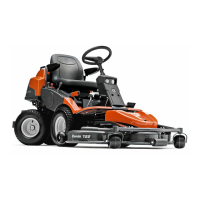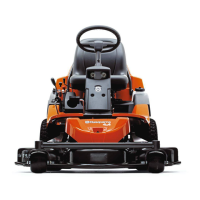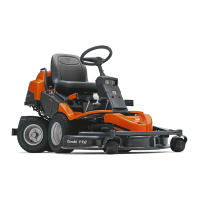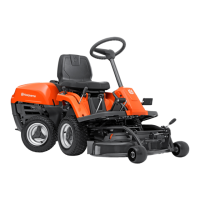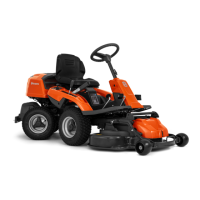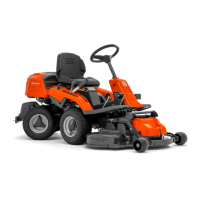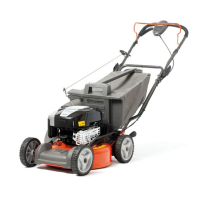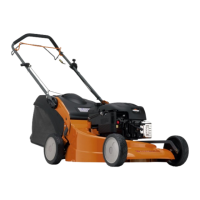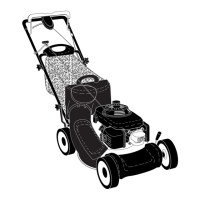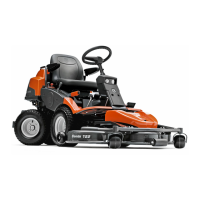
Do you have a question about the Husqvarna R 422 Ts and is the answer not in the manual?
| Cylinders | 2 |
|---|---|
| Fuel Type | Gasoline |
| Oil Filter | Yes |
| Cutting Width | 107 cm |
| Cutting Deck Material | Steel |
| Blades | 3 |
| Seat Material | Vinyl |
| Transmission Type | Hydrostatic |
| Engine Cooling | Air |
| Blade Engagement | Electric |
| Hour Meter Type | Digital |
| Front Wheel Size | 15 x 6.00-6 |
| Sound Power Level, Guaranteed (LWA) | 100 dB(A) |
| Mulching Capability | Yes |
| Bagging Capability | Yes |
Guidance for personnel with general knowledge of repair and service of riders.
Details hazardous properties of fuel and safety precautions for specific tasks.
Explains risks associated with sparking near the battery and how to avoid them.
Instructions for using a laser tachometer for speed measurement and maintenance.
Technical specifications for machine dimensions, weight, and wheelbase.
Details tyre dimensions and recommended air pressure for the wheels.
Information on engine model, power, displacement, fuel, and oil requirements.
Manufacturer, type, and oil specifications for front and rear drive axles.
Details on battery, fuses, spark plugs, and bulbs for the electrical system.
Max working pressure for the hydraulic system and steering servo circuit.
Specified torque values for various bolts and components for proper assembly.
Specifications for cutting widths, heights, blade lengths, and noise levels for different cutting units.
Step-by-step guide for dealers to prepare and deliver the machine to customers.
Schedules for required maintenance services at different operating hours (e.g., 25h, 50h, 100h).
Guidelines for dealers on customer handover, paperwork, and information sharing.
Procedures for fitting and connecting the battery, and checking steering wheel installation.
Steps for checking engine oil, hydraulic oil, tires, and fitting components before initial operation.
Procedures for testing the engine, cutting unit, and final checks before delivery.
Steps for completing sales documentation and confirming service delivery.
Introduction to Husqvarna R 422 Ts/AWD, highlighting articulated steering and hydrostatic transmission.
Description of the Combi 112 and Combi 122 cutting units and their functions.
Location and importance of machine, engine, and transmission serial numbers for ordering parts.
Details about the twin-cylinder engines, catalytic converter, and lubrication system.
Explanation of articulated and hydraulic power steering mechanisms for ease of operation.
Information on hydrostatic transmission, AWD, front/rear axles, and oil drainage.
How the Combi unit functions as BioClip or rear ejection, and its front-mounted design.
Detailed steps for removing and fitting the engine, including associated components.
Procedures for removing and fitting the fuel tank, including safety warnings.
Guide for changing engine oil and filter, including oil types and disposal information.
Instructions for checking and adjusting steering cables for proper operation.
Procedures for replacing steering cables and fitting/removing the power steering unit.
Steps for removing and fitting the cable pulley assembly.
Instructions for adjusting the parking brake on both R 422 Ts AWD and R 422 Ts models.
Guide for adjusting the hydrostatic transmission cable for correct operation.
Procedures for checking and adjusting throttle and choke cables.
Steps for replacing bearings in the articulated steering system.
Instructions for removing/fitting the pendulum shaft and replacing bushings.
Procedures for removing and assembling front and rear axles, including oil checks.
Guide for synchronizing front and rear wheel drives for correct cornering performance.
Detailed steps for replacing seals on outgoing shafts to prevent transmission leaks.
Comprehensive guide for removing and fitting the hydrostatic transmission cable.
Procedures for bleeding the hydrostatic and hydraulic systems to remove air.
Guidance on changing transmission oil, including recommendations for usage.
Steps for adjusting the lever housing for proper cutting unit lift and microswitch operation.
Instructions for replacing the rear drive belt, hydraulic pump drive belt, centre belt, and front belt.
Procedures for removing and fitting the equipment frame, including adjustments.
Steps for fitting and removing the cutting unit, including service position setup.
Procedures for adjusting unit parallelism, cutting height, and ground pressure.
Instructions for changing the cutting unit belt, removing/replacing blades with bearings, and sharpening.
Steps to remove the BioClip plug for converting the cutting unit to rear ejection.
Visual guide to the machine's electrical system and component identification.
Procedures for servicing the ignition and starter lock, hour meter, and fuses.
Step-by-step guide for replacing the machine's light bulbs.
Explanation of the rider's safety system and daily checks for proper function.
Details on mowing deck and seat microswitches, and pedal arrangement adjustments.
Importance of hydraulic hygiene, oil types, and filter changes for system longevity.
Diagrams showing the location of hydraulic system components for R 422 Ts and AWD models.
Procedures for bleeding the hydraulic system and servicing the power steering.
Steps for replacing the lift cylinder and servicing the hydraulic valve block.
Procedures for changing the hydraulic oil filter and replacing the control valve.
Information on the pressure limiting valve and identification of hydraulic hoses via marking.
Steps for changing the hydraulic oil cooler and replacing the cooling fan.
Problems with the starter motor, relay, or battery.
Issues with spark plugs, ignition coil, or connections causing no spark.
Causes of no start due to fuel tank, filter, pump, or carburetor issues.
Incorrect spark plug, ignition settings, or faulty ignition module.
Clogged filters, fuel pipes, or carburetor problems affecting running.
Issues with cooling fins, air intake, or engine overheating.
Impact of overloading or improper driving on engine performance.
Problems related to exhaust system, engine damage, or erratic running.
Worn belts, slipping pulleys, or idler issues affecting power transmission.
Low oil, pump leaks, or a defective accelerator impacting drive.
Parking brake faults, incorrect throttling, or transmission engagement issues.
Problems with axles, internal transmission damage, or lack of drive engagement.
Problems with engine speed, cooling fan, or airflow causing reduced power or noise.
Noises from worn belts, damaged pulleys, or internal transmission faults.
Noises originating from axles, brakes, or control linkage issues.
Noise caused by foreign objects, incorrect throttling, or other operational factors.
Factors leading to transmission overheating, such as poor air circulation or fan problems.
Problems with low oil levels, parking brake faults, or transmission control system errors.
Problems with drive belts, accelerators, or transmission engagement causing jerky starts or no drive.
How user actions or incorrect machine setup can lead to uneven mowing.
Problems with blades, unit settings, grass buildup, tire pressure, or loose parts.
Causes of engine vibration, such as mounting issues or cylinder problems.
